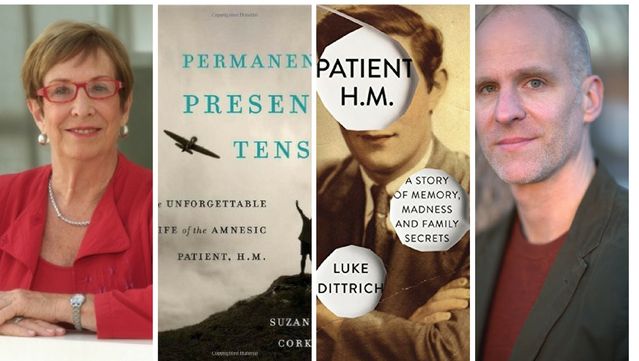Ethics and Morality
A Tale of Science, Ethics, Intrigue, and Human Flaws
Another look at the New York Times portrayal of a new book about amnesiac HM
Posted August 8, 2016

"Why Sir, if you have but one book with you upon a journey let it be a book of science. When you read through a book of entertainment, you know it, and it can do no more for you, but a book of science is inexhaustible." This quote of Samuel Johnson's was recorded by his Scottish friend, James Boswell, in his book, Journal of a Tour to the Hebrides, published in 1785, a year after Johnson's death.
This is how I began my review (see the review here) of Suzanne Corkin's biography of Henry Molaison, Permanent Present Tense: The Unforgettable Life of Amnesic Patient, H.M. published in May, 2013, five years after HM’s death in December, 2008. What a fine and uplifting quote it is. And indeed, Corkin’s book, in my view, is an inspiring tale of scientific discovery.
On August 9th, 2016, another HM book is being published. Patient H.M.: A Story of Memory, Madness, and Family Secrets is by journalist Luke Dittrich, and like Corkin’s book back in 2013, it has been getting a lot of attention. (Read my review of Dittrich’s book here.)
Just before it was due to be released, the New York Times Magazine published a controversial article, first online (read article here) and then on Sunday, August 7th, in their print edition. This article was provocative in that it was primarily an extract from the final chapters of Dittrich’s book, where he reports and interprets an acrimonious disagreement between Corkin and the neuroanatomist, Jacope Annese, from U.C.S.D. who, at Corkin’s invitation, undertook the monumental and career-changing task of sectioning HM’s brain (into 2401 slices), making high resolution images of it that later could be used to create a 3-D digitized model of the brain. Incredible, and at first an exciting and wonderful collaboration between scientists of different disciplines.
But it all went pear-shaped when Annese submitted the first article to result from this sectioning on the neuroanatomy of HM’s brain. He submitted it to a major journal without collaborating on it with Corkin or even asking for her comments before submitting it. This is at the very least naïve on Annese’s part and certainly not good scientific practice. Corkin was sent the paper to review by the journal, an interesting aside in itself, and her disquiet resulted in a meeting between the scientists, universities and funding bodies involved in the HM research project. The article reported a previously unknown orbitofrontal lesion and implied that this might put into question the mass of data from HM studies on memory deficits and their relation to damage to the hippocampus and adjacent structures. Corkin’s view, as reported by Dittrich, was that Annese’s article included “melodrama” and needed “to be rewritten, as a serious scientific document.” The meeting resulted in the two scientists collaborating on a revision of the article, which was duly published, with the frontal lesion reported but not the “melodrama” of any suggestion that it might negate the memory findings of the past 50 years.
Any neuropsychologist reading the final published paper would know immediately that if anything, the small frontal lesion, probably accidently caused by the neurosurgeon when he operated on HM’s brain, might be a factor in HM’s rather benign and passive personality, but would have no significant effect on his memory—or lack of it. Why? Because thousands of memory studies on hundreds of patients since HM have confirmed the HM findings on the importance of the hippocampus and surrounding structures to new learning and memory. Thus it is plain why Corkin was disturbed about that original article, and a lesson for all scientists about the importance of collaboration in appropriate interpretation of data when more than one specialty is involved. A neuroanatomist is usually not an experienced neuropsychologist and vice versa. It is again naïve or even arrogant to think otherwise.
But the trust between Corkin and Annese was irreparably damaged, and that I imagine fueled the next disturbing disagreement between M.I.T. and U.C.S.D. (where Annese had his lab), about the “ownership” of HM’s brain following the sectioning of it. Questions of who owns human tissue are not uncommon in hospitals and research institutes, and it is only in recent years that in most first world countries the right of the patient to ownership of their own tissue has been clarified. HM’s legal conservator (and you can judge for yourself whether the conservator was chosen appropriately), with HM’s ready agreement whenever he was asked, had certainly signed the release form for HM’s brain to go to M.I.T. and Mass General Hospial. No surprises there; HM had spent almost fifty years of his life contributing to science carried out by those two institutions, and in the moment he seemed to understand and indeed feel good about this. M.I.T. and Suzanne Corkin also cared for him, financing all his medical care and the high quality home in Hartford he lived in for 47 weeks of every year.
Note that he was not “relentlessly” questioned and assessed, as stated in the NYT article, but usually spent only two periods of two or three weeks a year at the very comfortable M.I.T. Clincal Research Center—basically a small private hospital—and when there was usually “tested” for only one to three spread-out hours a day. Otherwise he did his crosswords and watched TV and chatted to the staff just as he did in the home in Hartford. Everyone in Professor Corkin's lab was taught how to work with him, giving him frequent breaks because he would not tell you if he was tired. Sue was exacting in her research and in her adherence to the empathetic and ethical protection of participants in experiments. I know her colleagues and ex-students made this clear (as I did) in our interviews with Dittrich. Once H.M. became amnesic, if he had not become an experimental participant he would almost certainly have had a much more terrible life, forgotten and possibly neglected or abused in a back ward of a nursing home or a psychiatric institution somewhere.
Another emphasis in the extract published in the NYT article was that of Corkin’s response to a question by Dittrich; she said that much of the raw data from the thousands of HM experiments had been shredded. Dittrich was shocked and was not convinced by Corkin’s explanation that it is the published, peer-reviewed data—experimental results including tables of the data, analysis and interpretation—that is important, and raw data sheets viewed out of context, perhaps by non-specialists, could be badly misinterpreted. Again we see Corkin, the careful scientist here, but as well we can see Dittrich’s point of view. As he said, HM is not just any patient.
However, I remember some of that raw data from when I was at M.I.T. in 1986, and much of it would consist of paper data forms for experiments with hundreds of trials, coded as 1, 2, 2, 1 etc, or Yes, No, Yes, Yes, as the researcher noted the responses the participant made. Data sheets would be identified by codes stored separately to ensure that the patent’s identity was protected (standard ethical practice when storing the data for all human participants). Probably a lot of HM’s raw data would be useless as a source of usable data many years later, simply because it hadn't necessarily been stored in a perfect order with annotations of where, when, by whom etc (scientists can be as busy, stressed and even messy at times, just like other humans). In most universities and research establishments there is an ethical requirement to retain raw data for a minimum of 10 years. Scientists who have 20 years of raw data, let alone 50 years of data, will know that unless their institution provides secure storage for those data (and the data of every researcher in the university) it would soon be impossible to get into one's office or lab. Before the days when computers were in common use, that was how it was. No university could possibly have space for every researcher's data forever. Today we have computers, and it is easy to store, although who knows how accessible that will be in another twenty years? Nevertheless, one might hope that M.I.T. has had the foresight to employ science archivists to sort and store, or even scan, those data which make any sense at all, for posterity. Indeed, we don’t really know how much data is still kept securely at M.I.T. until we hear from directly from them.
The provocative NYT article will surely be good for book sales. Sadly, Sue Corkin died in May this year, after losing a stern fight with cancer, and the timing and emphasis of this NYT article and the book release is unfortunate. It is no surprise that Random House in its giant commercial wisdom did not delay it for a few more months. However, I do not think the book itself is a bad thing, if read, as all books of this genre should be, with a realization that this is one point of view, and that of a journalist, not a neuroscientist. Dittrich did most of his research thoroughly but he was constrained by who would talk to him and in how much detail, and made decisions about which data he would use. He spoke extensively with Jacope Annese for example, and thus Annese’s views are strong in the book. Sue Corkin only reluctantly permitted two brief interviews very late in the process, when she was already seriously ill, and was clearly irritated and stressed by the whole affair.
Nevertheless, the book itself is important partly because it is not simply a journalist, any journalist, reporting a story about something unrelated to him. Dittrich is the grandson of William Beecher Scoville, the neurosurgeon who performed the experimental and unethical operation on HM in an attempt to cure his epilepsy. Instead he turned HM into the man with the most profound amnesia in history. His surgery was unethical because it is impossible for anyone to fathom (including his grandson) why he would remove the hippocampus and amygdala on both sides of HM’s brain. One side, maybe—this was already being done at the Montreal Neurological Institute by Wilder Penfield, one of the greatest and most ethical neurosurgeons of his day. But on both sides of the brain when no-one had a clue what the hippocampus even did? This is the behavior one might expect from that stereotypical myth of a neurosurgeon; the man who can’t be trusted with a scalpel. And here is the twist to the story of Dittrich’s book, and the thing that in my view makes this an important book (the unfair implications about Suzanne Corkin aside): Dittrich tells the story of Scoville, warts and all, for the first time. Yes, we all knew he was one of the most “productive” lobotomists of his time, and by anyone’s count a surgeon any fully-informed patient wouldn’t go near, but Dittrich’s research about the grandfather he loved, and who died (while driving one of his favored fast cars) when Dittrich was nine, is exhaustively researched and shocking. It is in fact the guts of the book in my opinion, and the story of HM and Suzanne Corkin and all the other people who worked with HM and cared for him and protected him from exploitation after Scoville had crippled his memory and his life is almost secondary. If only the NYT had chosen to use an extract about Scoville rather than Corkin, perhaps the hype (melodrama, as Sue might say?) around this book would be less distressing for the scientific community who knew Corkin and respect her as a fine and ethical scientist, an inspiring mentor to her students and colleagues, and most especially a model for women in science.
So in conclusion, this is what I think, having read both books and considered them in detail. If you are a psychology, neuroscience or medical student or professional or teacher, read both of these books, one after the other, and you will learn much about the history of science, scientific and medical ethics, memory, and most of all human nature, that legacy we are all saddled with. On the way, you will appreciate better the complexities of studying the human brain, you may feel more empathy and less anger at the scientists and journalists in their search, however flawed, for the truth. Most of all you will honor the sacrifice HM made for science and every one of us over the half century following that terrible day when his memory disappeared as the neurosurgeon sucked out two essential bits of brain.
Please subscribe to my monthly e-newsletter!




